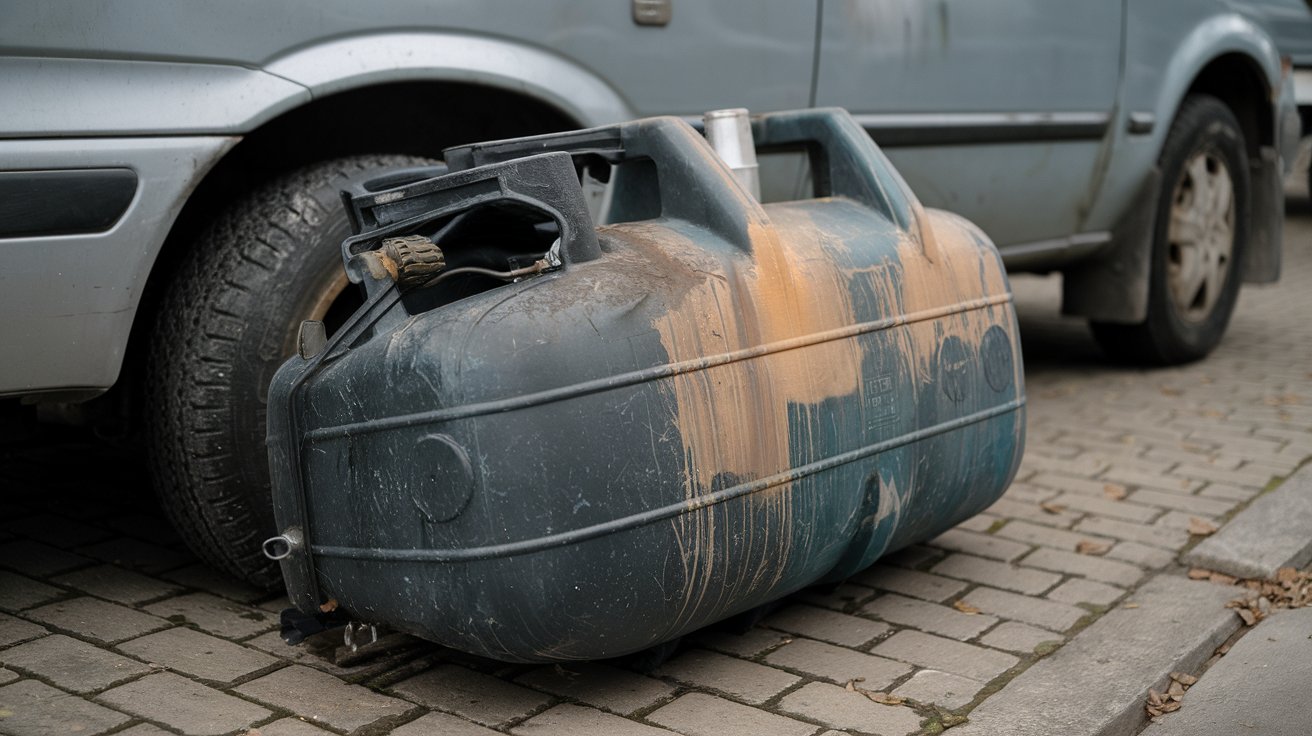Plastic fuel tanks have become a staple in modern vehicles, prized for their lightweight and corrosion-resistant properties. However, like any component, they can develop issues over time, such as leaks, cracks, or punctures.
Understanding how to repair plastic fuel tanks is crucial for maintaining your vehicle’s performance and safety. Whether you’re dealing with a minor leak or significant damage, knowing the right techniques and materials can make all the difference.
This comprehensive guide will walk you through an effective method to fix your plastic gas tank, highlight common mistakes to avoid, and discuss the safety aspects of tank repairs, incorporating expert insights from seasoned professionals.
Step by Step Guide on How to Repair Plastic Fuel Tanks
Repairing a plastic fuel tank may seem daunting, but with the right tools and knowledge, it can be a straightforward process. The key lies in identifying the type of plastic your tank is made from and using the appropriate repair system. Most plastic fuel tanks are made of polyethylene, which comes in two primary forms: thermoset and thermoplastic. It’s essential to determine which type you’re dealing with before proceeding with any repairs.
Step 1: Identify the Plastic Type
- Locate any markings or labels on the tank that indicate the type of plastic.
- If no markings are present, contact the manufacturer for information.
- Determine if the plastic is thermoset (cross-linked) or thermoplastic:
- Thermoset plastics will sand and powder when abraded.
- Thermoplastics will melt and self-heal when heated.
Step 2: Gather the Necessary Equipment
- Obtain a plastic welding kit (e.g., Polyvance nitrogen plastic welder).
- Select the appropriate welding rod matching the tank’s plastic type (e.g., LDPE for polyethylene tanks).
- Prepare safety equipment: gloves, safety glasses, and a respirator.
- Gather additional tools: sandpaper, cleaning solvent, and a grinding tool.
Step 3: Prepare the Repair Area
- Clean the area around the damage thoroughly with a solvent to remove dirt and oils.
- Sand the area surrounding the damage to create a rough surface for better adhesion.
- Wipe away any dust or debris from sanding.
Step 4: Set Up the Plastic Welder
- Connect the nitrogen gas supply to the welder if using a nitrogen plastic welder.
- Install the appropriate welding tip for the size of the repair.
- Load the correct welding rod into the welder.
- Set the temperature according to the manufacturer’s recommendations for the specific plastic type.
Step 5: Perform the Repair
- Heat both the damaged area and the welding rod simultaneously.
- When both are in a molten state, apply the rod to the damaged area.
- For holes, bridge over the opening with the molten rod material.
- Ensure enough material is forced into the hole to create a “mushroom” effect on the backside.
- For larger repairs, work in small sections, allowing each area to cool before moving to the next.
- Build up the repair area slightly higher than the surrounding surface.
Step 6: Allow the Repair to Cool
- Let the repaired area cool naturally. Do not force cool with water or compressed air.
- Wait until the repair is completely cooled before proceeding.
Step 7: Finish the Repair
- Once cooled, use a grinding tool to smooth the repaired area flush with the surrounding surface.
- Sand the area progressively with finer grits of sandpaper for a smooth finish.
- If necessary, apply texture to match the original surface (not always required for hidden repairs).
Step 8: Test the Repair
- For fuel tanks, perform a pressure test to ensure the repair is leak-free.
- Install an air fitting into an appropriate opening on the tank.
- Apply low-pressure air and spray soapy water over the repaired area.
- Check for bubbles, which would indicate a leak.
Step 9: Final Touches
- If the repair passes the pressure test, clean the entire repaired area.
- Apply any necessary paint or coating to protect the repair and match the tank’s appearance.
What Can I use to Seal a Plastic Gas Tank?
Sealing a plastic gas tank requires materials that can bond effectively with plastic and withstand exposure to gasoline. One of the most reliable options is epoxy, which provides a strong, durable seal. Epoxy adhesives are designed to bond different materials and can fill gaps or cracks seamlessly. Additionally, specialized fuel tank repair kits are available, which often include epoxy, fiberglass patches, and other necessary components for a comprehensive fix.
Another option is using a high-quality plastic welder. Plastic welding involves melting the damaged area and adding filler material to restore the tank’s integrity. This method requires some skill but can create a long-lasting repair if done correctly. Alternatively, JB Weld offers products that are specifically formulated for plastic repairs and can be an effective solution for minor leaks and cracks.
Can a Plastic Gas Tank be Repaired?
Yes, a plastic gas tank can be repaired, but the feasibility depends on the extent of the damage. Minor leaks and small cracks are generally repairable using epoxy, fiberglass patches, or plastic welding techniques. For larger cracks or extensive damage, it might be more practical to replace the tank altogether to ensure safety and functionality.
When considering a repair, it’s crucial to assess the location and size of the damage. Repairs near the bottom of the tank, where gasoline tends to collect, may be more challenging and require more robust solutions such as fiberglass patches or professional plastic welders.
Additionally, ensuring that the repair area is thoroughly cleaned and prepared will enhance the bond strength and longevity of the fix.
Best Item to Patch a Plastic Gas Tank
When choosing the best item to patch a plastic gas tank, epoxy resin stands out as a top choice due to its strong adhesive properties and resistance to gasoline. Epoxy can create a watertight seal that prevents leaks and extends the life of the fuel tank. Another excellent option is fiberglass repair kits, which provide added strength and flexibility. These kits typically include fiberglass cloth, resin, and hardeners that work together to reinforce the damaged area effectively.
For those who prefer a quick and easy solution, commercial fuel tank repair kits are available. These kits often contain premixed epoxy, patch materials, and detailed instructions, making them user-friendly for DIY enthusiasts.
Additionally, using a plastic welder can offer a permanent fix by melting the tank material and integrating the patch seamlessly. Whichever method you choose, ensure that the materials are compatible with plastic fuel tanks and suitable for use with gasoline.
What to Avoid when Repairing a Plastic Fuel Tank?
While repairing a plastic fuel tank can be manageable, certain pitfalls can compromise the effectiveness and safety of the repair.
- One common mistake is using the wrong type of adhesive or filler. Not all adhesives are designed to withstand the harsh chemicals in gasoline, so it’s essential to choose products specifically formulated for fuel tank repairs. Using improper materials can lead to further leaks and potentially hazardous situations.
- Another mistake to avoid is neglecting proper surface preparation. Failing to clean and dry the damage area thoroughly can prevent the adhesive from bonding correctly, resulting in a weak seal. Always remove any dirt, grease, or residual fuel from the repair site before applying epoxy or patches. Additionally, avoid repairing a tank that has severe structural damage, as this can compromise the entire vehicle’s safety.
- Over-tightening clamps or applying excessive pressure during the repair process can also cause more harm than good. It’s important to follow the manufacturer’s instructions carefully and use appropriate techniques to ensure a secure and lasting fix.
- Lastly, never ignore safety precautions such as disconnecting the fuel supply and working in a well-ventilated area to prevent accidents during the repair.
Is It Safe to Just Repair a Plastic Fuel Tank?
Repairing a plastic fuel tank can be safe if done correctly and with the right materials. Ensuring that the repair is thorough and adheres to safety standards is crucial to prevent fuel leaks and potential hazards. When using high-quality epoxy or fiberglass patches, the repair can restore the tank’s integrity, making it as safe as when it was new.
However, it’s important to consider the extent of the damage before deciding to repair. Minor leaks and small cracks are generally safe to fix, provided the repair is done meticulously. For significant damage, such as large cracks or multiple leaks, replacing the tank might be the safer option to avoid future risks. Always follow safety guidelines, such as working in a well-ventilated area and wearing protective gear, to minimize the risk of accidents during the repair process.
Additionally, after repairing the tank, it’s advisable to monitor the repair area regularly for any signs of deterioration or new leaks. Regular maintenance and prompt attention to any issues can help ensure the long-term safety and functionality of your plastic fuel tank. Remember, the goal is to maintain a secure and leak-free tank to safeguard both your vehicle and your surroundings.
When Is It Not Repairable?
There are instances when repairing a plastic fuel tank is not feasible or safe. If the tank has extensive structural damage, such as multiple large cracks or severe deformation, a repair might not restore its integrity adequately. In such cases, replacing the tank is the most reliable solution to ensure safety and performance.
Additionally, if the plastic fuel tank has been compromised by external factors like excessive heat, chemical exposure, or age-related degradation, repairs may not hold up over time. Tanks that have warped or lost their shape may not provide a proper seal even after a repair, leading to recurring leaks and other issues. It’s also important to consider the location of the damage; repairs near the base of the tank, where fuel can accumulate, may not be as effective and could pose a higher risk of failure.
Another situation where repairing might not be advisable is if the tank has been punctured by sharp objects, significantly weakening its structure. In such scenarios, even a high-quality patch or weld might not offer the necessary strength and durability.
Consulting with a professional mechanic or fuel tank specialist can help determine whether a repair is possible or if a replacement is the better option to ensure your vehicle’s safety and reliability.

